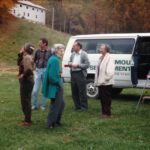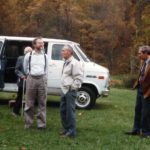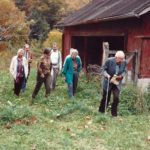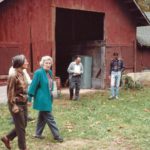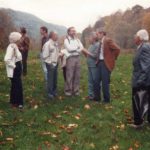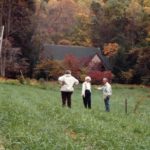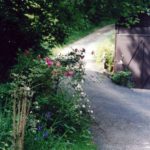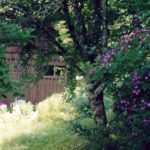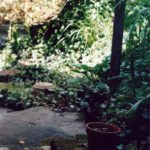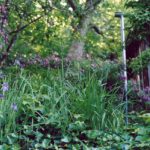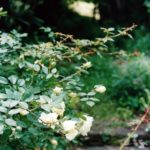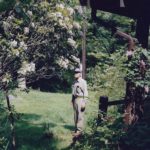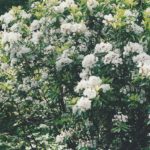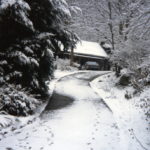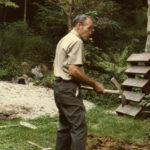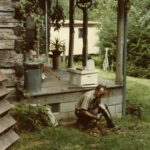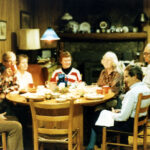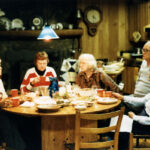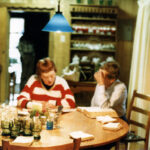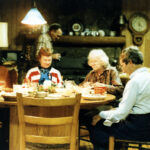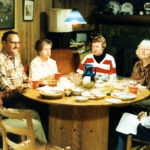Pine Mountain Settlement School
Series 09: BIOGRAPHY
William Hayes, Student, Staff, Trustee, 1934-2006
William Hayes (1914-2006)
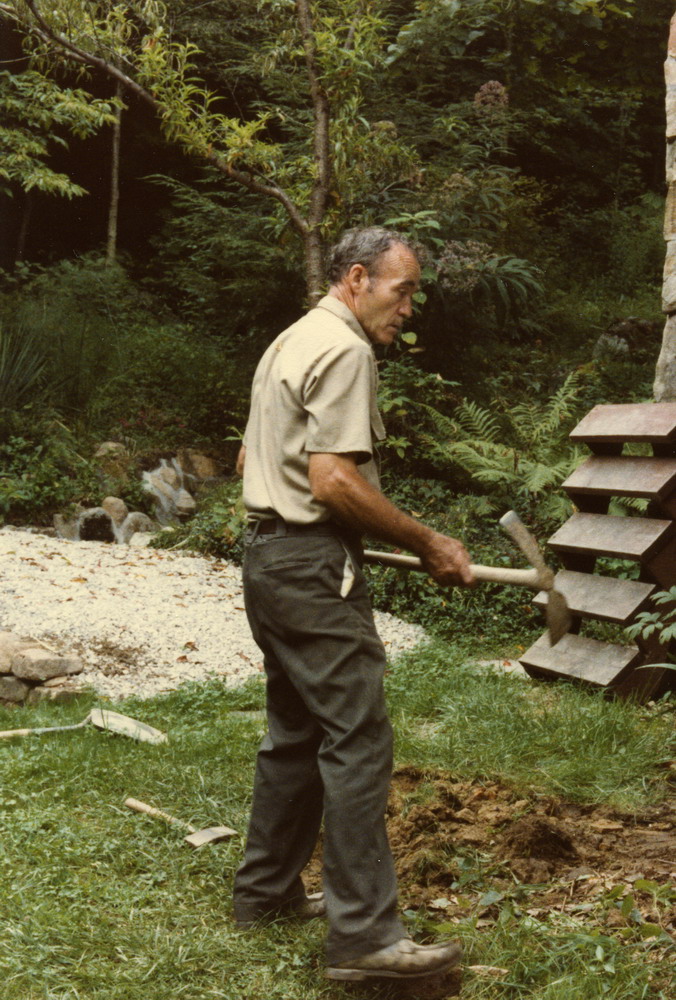
William Hayes, at work on cabin steps. [hay0230.jpg]
TAGS: William Hayes, Bill Hayes, Fern Hall Hayes, farm manager, Dr. Richard Drake, Berea College Service Award, surface mining, SMCRA, Kentucky Division of Forestry, US Forest Service, Daniel Boone National Forest, Red River Gorge, Little Shepherd Trail, Kentenia State Forest, forestry, scenic roads, Wilson Wyatt, Office of Surface Mining, US Department of the Interior, reclamation, Lands Unsuitable for Mining, coal mining, coal camps, tuberculosis, Dr. Willis Weatherford, Howard Burdine, Native Americans, Pine Mountain Settlement School Board of Trustees, American Indian pictographs, woodcraft, Robin Lambert
WILLIAM HAYES Student, Staff, Board (Part 3), 1934-2006
NATIVE AMERICAN Artifacts
The documenting of Native American cliff dwellings, pictographs, and artifacts during work as a farmer and as a reclamation supervisor was a long-standing interest of Bill. Many surface mining sites and artifacts were destroyed by surface mining before discovery or before the appropriate intervention could be arranged. Bill was able, in some cases to document location, pictographs, and other indicators of Native American habitation. Now buried under tons of overburden or blown away, these early sites continue to be destroyed before legal action can be initiated to prevent destruction. Unfortunately, most were already vandalized by artifact hunters and other acts of irresponsible behavior before surface mining removed entire mountain tops.
Bill’s collection of artifacts gathered over many years, were donated to Pine Mountain Settlement School in 2004 and along with other collections, that of Fred Burkhard and James Faulkner, the 3 collections form the nucleus of the Native Americans educational module in the Environmental Education program at the Settlement School.
WILLIAM HAYES (Part 3): Back to Pine Mountain – Board of Trustees 1984–2003
Following his departure from the Office of Surface Mining, Department of the Interior, in 1983, Bill became a member of the Pine Mountain Settlement School Board of Trustees. His many years of employment at the School, his years of service to the School while at the Putney Ranger Station, and his subsequent years of support when called upon, made him particularly well suited for trustee work at the School. Again, he entered a responsibility at a time of considerable conflict. At the School, the Director position was again changing and the School had found itself at the center of the surface mining debate in the region. Further, his brother Paul Hayes was selected to manage the School as an Interim Director in the absence of a full-time Director.
Bill provided support mainly for the Buildings and Grounds Committee, as his familiarity with the structures on campus and their history filled in many gaps related to the preservation and maintenance of the structures and the grounds.
GALLERY I: Board Reviewing PMSS Structures and Grounds
- Members of the Buildings and Grounds Committee, c. 1984. (lft. to rt.) ?, Ben Begley, M. Pride, Paul Hayes, Milly Mahoney, Burton Rogers, ? PMSS BOT
- William Hayes with ?, Burton Rogers (behind) and James Greene III, members of the PMSS BOT – Building and Grounds Committee, c. 1984.
- Milly Mahoney, James Greene III, ?, ?, M. Pride, and Burton Rogers at Barn at PMSS BOT – Building and Grounds Committee, c. 1984.
- Paul Hayes(center) with BOT members (M. Pride) and Ben Begley to far rt. at PMSS Barn. Building and Grounds Committee, c. 1984.
- Ruth Shuler Dieter, ?, Ben Begley, Bill Hayes, Milly Mahoney, ?, Jane Bishop, James Greene, Burton Rogers – Building and Grounds Committee at PMSS, c. 1984.
- William Hayes (far rt.) Ruth Shuler Dieter (cntr) and ? (far lft) in Chapel field with members of the PMSS BOT – Building and Grounds Committee, c. 1984.
WILLIAM HAYES (Part 3): Lands Unsuitable for Mining Petition – Pine Mountain Settlement School
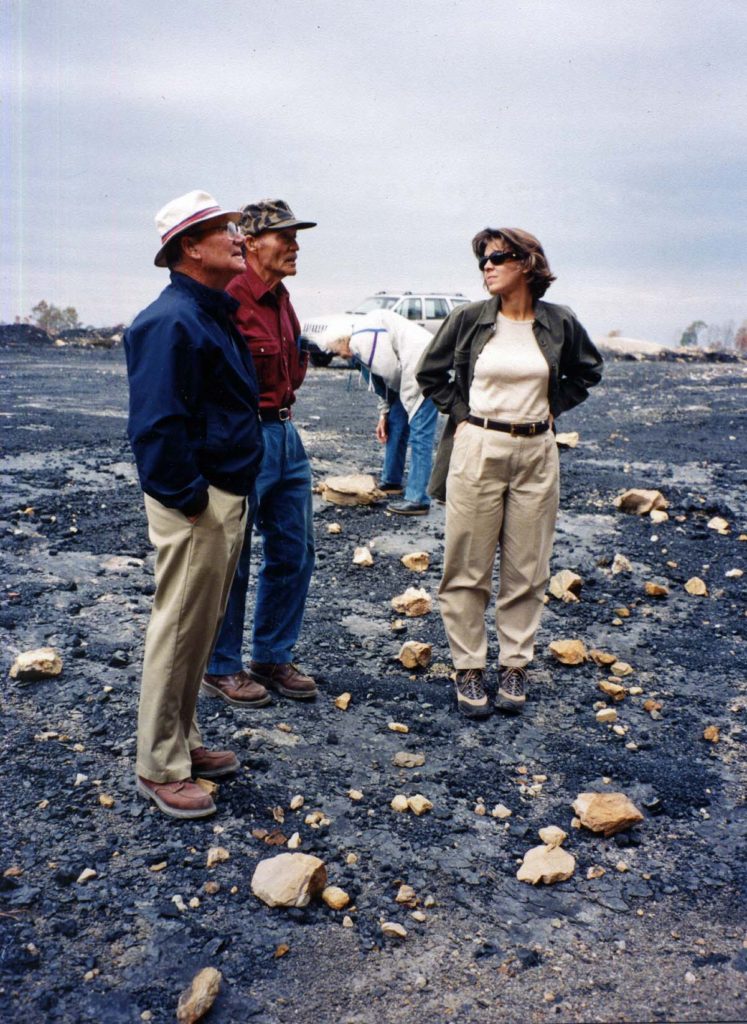
[lands_unsuit_001.jpg] Springer Hoskins, William Hayes, Fern Hayes, and PMSS Director, Robin Lambert on a surface mine site.
It aimed to ban the permitting of surface mining operations within the boundary of the petition which was the visual and sensory area surrounding the School. The petition was prompted by the actions of Nally and Hamilton Coal Company which had filed a preliminary application to remove coal using surface mining up to the boundaries of the School campus. The mining activity threatened the environmental activity of the School as well as the physical historic site and its buildings which would be susceptible to the large use of explosive charges among other depredations. The activity of the mining company was also seen as disruptive of the activities of the well-known environmental programs at the School and endangerment to school children who participated in the programming. The “Lands Unsuitable for Mining” petition was forwarded to James Bickford the Director of Natural Resources in Kentucky and was broadly distributed to the public in an attempt to stop the mining operation.
While the petition did not seek to alter the uses and the ownership of lands surrounding the School, only stop the destruction associated with surface mining so near the School, the “Lands Unsuitable for Mining” petition created a range of fears regarding the petition. The petition, described in the page PMSS LAND USE – LANDS UNSUITABLE FOR MINING, was forwarded to James Bickford the Director of Natural Resources in Kentucky, and was broadly distributed to the public in an attempt to stop the mining operation, Bill Hayes’ expertise as a former surface mining inspector was tested on many fronts during this contentious process. James Bickford later worked to protect a large forest tract at Pine Mountain now named the James Bickford Preserve at the School.
Editorial columns in newspapers and the media outside the region were solidly behind the Pine Mountain petition, particularly the Louisville Courier-Journal and the Lexington Herald-Leader but a counter-campaign was launched at the local level that sought to characterize the effort as an attempt to put people out of work and as a thinly disguised restriction on personal freedoms and personal land disposition. While there were nearly 3000 letters written to the State and all but 76 supported the Pine Mountain position, the position of the Governor, Paul Patton, a coal supporter, was a critical pivot in the outcome. Importantly, the Kentucky House of Representatives passed House Resolution 133 supporting the Pine Mountain Lands Unsuitable petition 95-0 and the reluctant Governor capitulated. The tide appeared to be turning for environmentalism in the State.
WILLIAM HAYES (Part 3): VIPER and the Hayes Cabin
During the years when Bill was negotiating the enforcement of surface mining legislation and surface mining realities in the region, Fern was working first for the local Community College and later for the Kentucky River Health District office in Hazard. But, Bill and Fern were also engaged in a personal endeavor — building their own home. In 1967, Bill and Fern moved to Viper, Kentucky, onto property once owned by Fern Hall’s ancestors. Philip Whisman Hall, an early ancestor, who came to Perry County in the middle 1800s as a surveyor and speculator. Philip Whisman, or, P.W., a Virginian, purchased considerable land along the North Fork of the Kentucky River in Perry County. On one of his steep hillsides, Myrtle Hall, Fern’s mother used to milk her cow on a “flat” of the mountainside, It was there on a small inherited lot that Bill and Fern began work on the reconstruction of three salvaged old log cabins to build themselves a home. It was to be the first home the couple had ever owned and it was built almost entirely by Bill with initial help from his two sons. Steve and Philip.
It was there that Bill and Fern gardened, grew rare and unique mountain plants and watched their grandchildren grow up nearby. It was on a steep mountain hillside that Bill raised his prize crop of tomatoes.
WILLIAM HAYES (Part 3): Gardening – “Tomatoes. A regular kitchen symphony.”
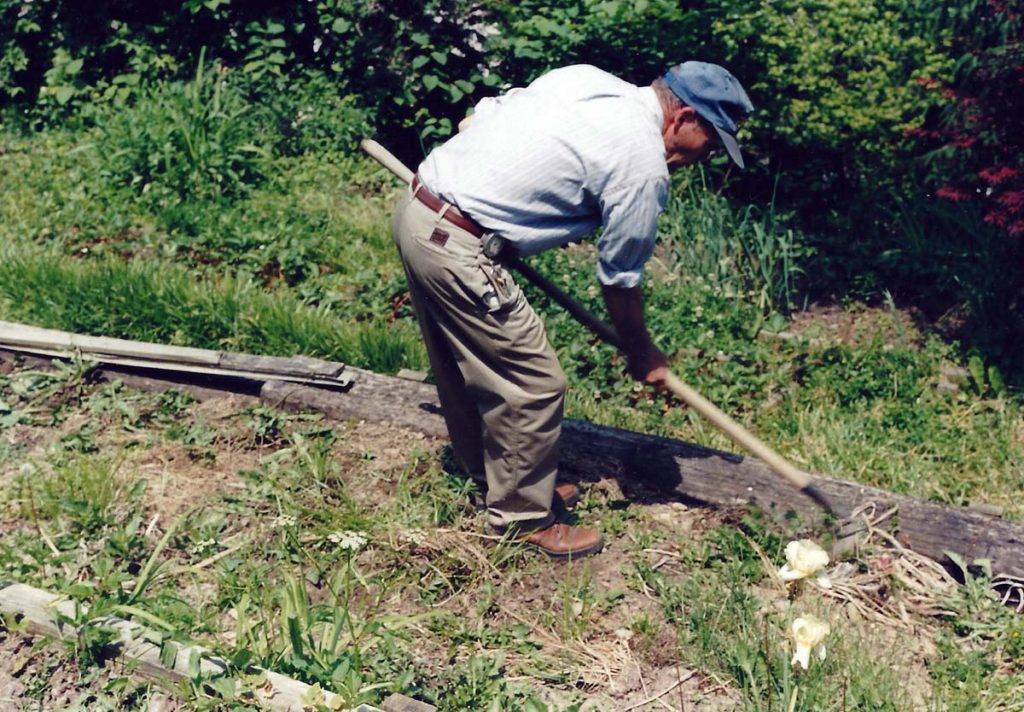
[hayes_garden_02.jpg]
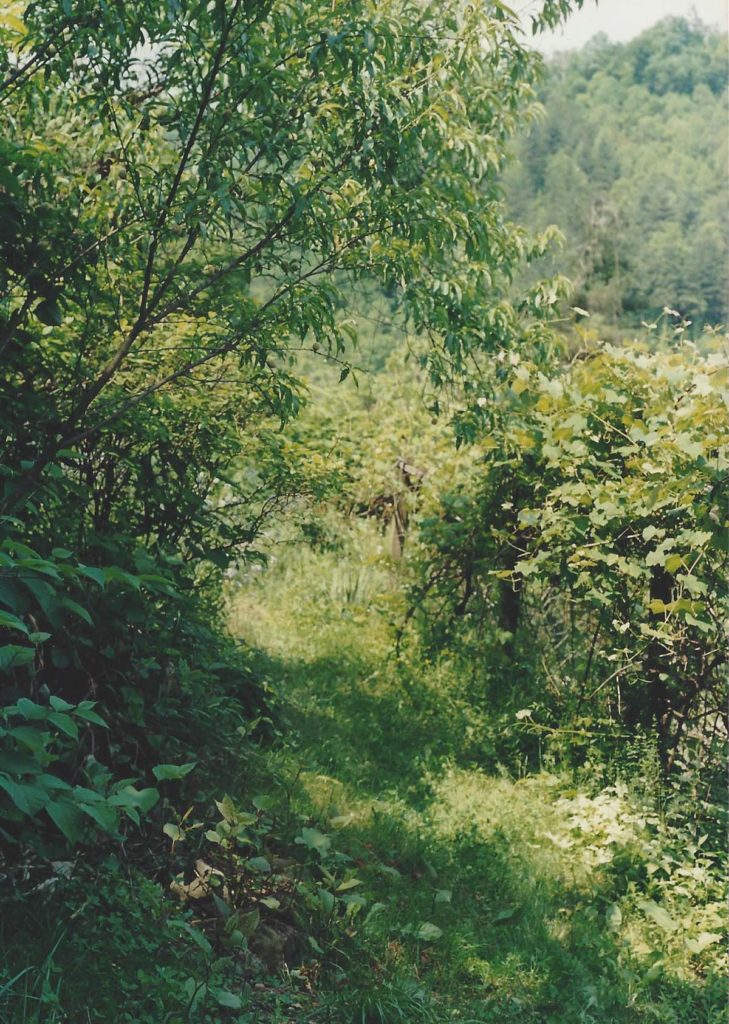
[hayes_garden_12.jpg]
Always an admirer of tomatoes of many varieties, Bill once described that summer fruit as a “…regular kitchen symphony.” Fern canned, strung “leather britches” (dried beans), shelled hickory nuts and walnuts sometimes turning them into pies. Dried apples were turned into “Massy” apple stack-cakes by Bill. Sassafrass bark made sassafrass tea and teaberry grew at their back door. Bill hand-fed his pet giant bullfrog in their small pond and took his dog Missy for long walks to check on his ginseng patch.
The ginseng, golden-seal plants and black cohosh never made it to the drying rack as they were raided in a land that still has little respect for property borders, Hopefully, the money from the seven-year-old ginseng plants stolen in the night went to feed a hungry family or get a miner through the month but, it is more likely that it went to feed a drug habit. Natural healing drugs for killer drugs —-
GALLERY III: The Garden at Viper Cabin
- Roses and road to Philip’s house, Garden at Viper cabin.
- The shop and the blue rose, Garden at Viper cabin.
- Garden at Viper cabin.
- The blue rose. Garden at Viper cabin.
- Cinnamon ferns in Spring. Garden at Viper cabin.
- The rose in Fern’s wedding boquet. Garden at Viper cabin.
- Garden at Viper cabin.
- Garden at Viper cabin.
The loss of ginseng and other plants and the crudeness of desperate people could not compare with the next turn of events. The pride Bill and Fern had in their monumental building task was dashed in 1980 when the State declared eminent domain over the cabin property in order to reconstruct Highway #7 from Jeff to Viper and the bridge that crossed Mason’s Creek at the intersection of Mason’s Creek with the North Fork of the Kentucky River. Not only was their property targeted but so was that of their son, their neighbors and many of the families along Highway #7.
Proposed as only 2.7 miles of reconstruction, the new road project was described by some as a political payback aimed at Bill and others and intrigued by a wealthy former coal operator whose mining practices had once been called into question. Others saw the road as a ruse of coal operators to gain access to mineral rights owned but having no right of way to access their bounty. The new road and bridge obliterated the property but possibly saved drivers lives on the short stretch of the highway. Just how much coal was retrieved is not known but the toll on the lives of Bill and Fern was cruel by any measure.
GALLERY IV: Hayes Cabin, Viper, KY
- William Hayes. Viper Cabin
- William Hayes, at work on cabin steps. [hay0230.jpg]
- William Hayes. At work on cabin steps while grand-daughter watches.
Over a ten-year period, Bill and Fern watched as political graft and pay-back finally triumphed and destroyed over twenty-five years of building their first truly personal domain. The road that took the cabin and all surrounding out-buildings and his son’s home was just 2.7 miles but it would end just feet beyond the far edge of Bill and Fern’s property. Kentucky initially proposed to take some 32 acres fee simple land (including mineral rights) on land that still retained all mineral rights. Though the final acreage taken was just over 4 acres following the assistance and intervention of the Kentuckians for the Commonwealth, the gross damage was complete and the home, greenhouse, workshop, garage, a neighboring house, their son’s home and all plantings were condemned by the Kentucky Department of Transportation. King Coal had won.
His son’s home could be moved, but Bill and Fern’s log home could not. The home and all the rare plants and vegetation and outbuildings would be bulldozed away and Bill and Fern were given the option to be relocated to “comparable” housing.
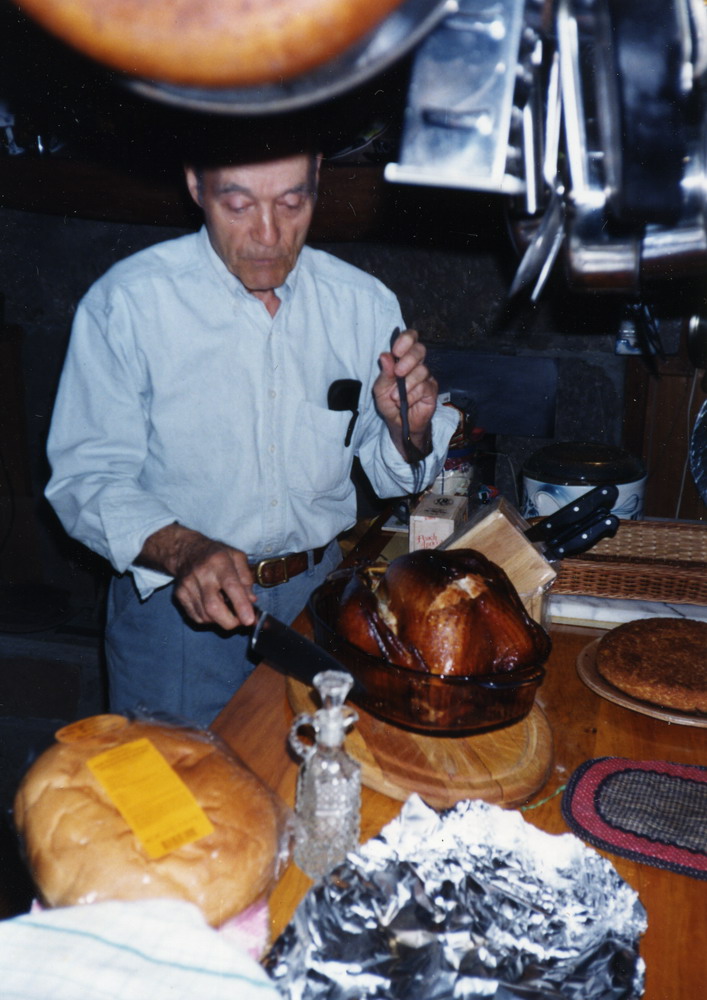
William Hayes. Thanksgiving in his kitchen. [hay0201.jpg]
The coal operator who brought and bought the road through this small corner of Kentucky, is long dead, as are many of the older folk whose health was broken by the ten-year struggle to save their land along the road’s path. For many on that short road, the story was a long and deadly one — It was an excavation and an execution. It was an assault on a lifetime of work and a reminder that even in our most sacred places, our homes, we are neither safe from greed nor protected by our government if enough money can be pushed across the table to shift men’s morals and minds. How did Bill handle the ten years waiting for the road to come?
WILLIAM HAYES (Part 3): Streams and Oceans
So, Bill went fishing.
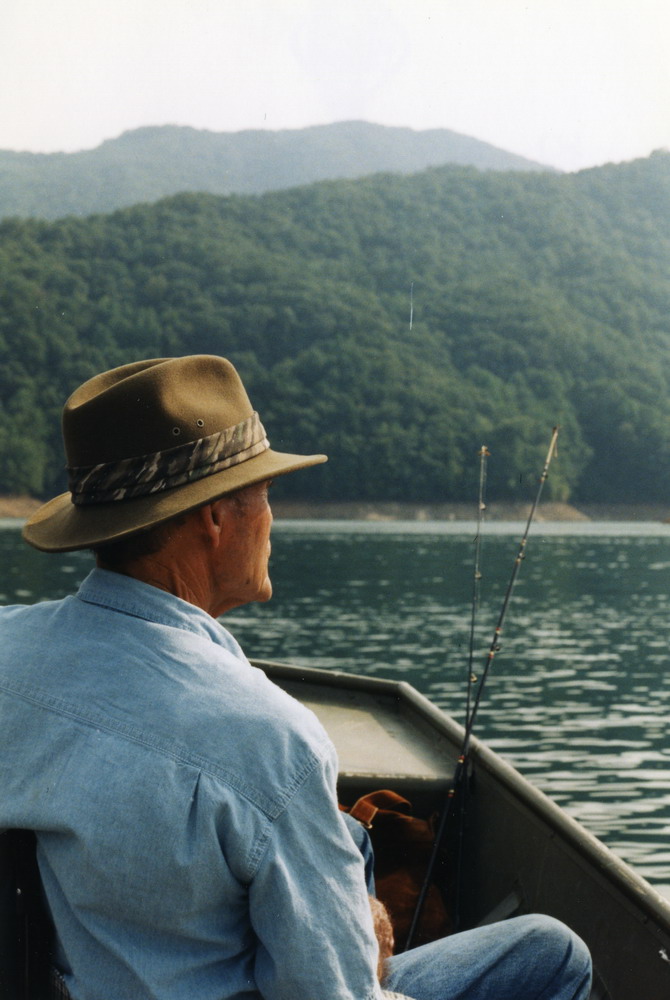
William Hayes. Lake Fontana, NC [hay0335.jpg]
Until the bulldozers came he fished some more, baked elegant Apple Stack cakes and drank possum grape wine and dandelion wine that Fern brewed in their basement, and spent hundreds of hours volunteering at nearby Pine Mountain Settlement School.
WILLIAM HAYES (Part 3): Wine Recipes
Source: Fern Hayes, 1963 January
DANDELION WINE
2 1/4 cups = 1 lb. sugar
([USE] 8 cups of sugar per gallon of liquid approx.)
Cover two quarts of dandelion blossoms packed in the measurer with four quarts of “well water” (bottled water). Boil for 20 minutes. Pour the hot liquid over two sliced lemons (some use oranges, peel and all) and allow to cool.
Add one cake of yeast and let stand for 48 hours. Strain and add 3 1/2 pounds of sugar. Stir and dissolve. Let stand six weeks. Bottle tightly ?
POSSUM GRAPE WINE
Crush fully ripe grapes let set for 2 days (48 hrs.) Squeeze on 3rd day (strain). Add 2 lbs of sugar to the gallon of juice. Store in a dark warm place — let set with a loose cover for about six weeks or until it stops working. Seal and store in a cool place.
BLACKBERRY WINE
Select ripe blackberries. Wash and measure. To one gallon of fruit put one gallon of water and let stand twenty-four hours to ferment. Strain.
To one gallon of this liquid add three pounds of brown sugar. Mix well and ferment for about six weeks, then seal tightly.
GALLERY V: Visitors at The Cabin
- Gathering at Hayes Cabin – Arthur Dodd, Annie Hayes, Georgia Dodd, Fern Hayes John Hayes, Mattie Ayers Hayes. [hayes_cabin_gatherings_001]
- Annie Hayes, Fern Hall Hayes, John Hayes.
- Georgia Ayers Dodd, Mattie Ayers Hayes. [hayes_cabin_gatherings_003]
- Arthur Dodd, Annie Hayes, Georgia Dodd, Fern Hayes
- Georgia Ayers Dodd, Paul Hayes, Fern Hall Hayes, Mattie Ayers Hayes. [hayes_cabin_gatherings_005]
- Paul Hayes, Annie Hayes, Georgia Dodd, Fern Hayes, John Hayes, Mattie Ayers Hayes. [hayes_cabin_gatherings_006]
WILLIAM HAYES (Part 3): UK Archive
The papers of William Hayes are held at Pine Mountain Settlement School. The University of Kentucky holds two large scrapbooks of newspaper accounts and correspondence related to Bill’s years with the Kentucky Department of Natural Resources and with the Department of the Interior, Office of Surface Mining (OSM). The University of Kentucky holdings is one of the most comprehensive documentation of news articles covering the history of surface mining and the work of the OSM in eastern Kentucky. Patrick Angel, the only forester for the Department of the Interior Office of Surface Mining and who trained with William Hayes, assisted in the assembly of the scrapbooks and the negotiations to process and hold the records in the University of Kentucky Special Collections.
See: The William Hayes coal mining scrapbooks (dated 1967-1997, (1.35 cubic feet, 2 boxes) consists of two scrapbooks of newspaper clippings created by William Hayes, a reclamation inspector, about coal mining in Kentucky.
Along with the scrapbook material is a large photographic collection (slides) that document the progression of surface mining during the early years of the industry and taken by William Hayes as he monitored his growing “aggravation.”
**********
William Hayes died on March 3, 2006, in Asheville, North Carolina, of Lewy Body disease, after a two-year fight with the neurological and brain-wasting disease, a kind of Parkinsonism. His ashes were scattered from the top of Jack’s Gap, the highest point along the Little Shepherd Trail that he helped to create and which looks out over the headwaters of both the Cumberland and the Kentucky rivers and the scarred mountains and forests he tried so desperately to monitor and save.

William Hayes. Seated in his forest hillside of beech trees and Purple Phacelia in Spring. 2005. Photo by Jessie Browning. [hay0196.jpg]
Previous:
WILLIAM HAYES Student Staff Board (Part 1)
WILLIAM HAYES Student Staff Board (Part 2)
See Also:
BILL BLAIR WWII Letters
DANCING IN THE CABBAGE PATCH Farm and Dairy II The Morris Years 1931-1941
DANCING IN THE CABBAGE PATCH Poultry
FERN HALL HAYES Student Staff – Biography
RELIGION Vespers Service William Hayes c. 1942
WILLIAM HAYES and KENTUCKY GUILD OF ARTISTS & CRAFTSMEN Correspondence
WILLIAM HAYES Family Photograph Collection
WILLIAM HAYES PERSONAL CORRESPONDENCE
(See William and Fern Hayes PMSS Personal Correspondence)
Return To:
BIOGRAPHY – A-Z
GOVERNANCE BOT Chronological Guide
GOVERNANCE BOT Alphabetical Guide to Board Members

